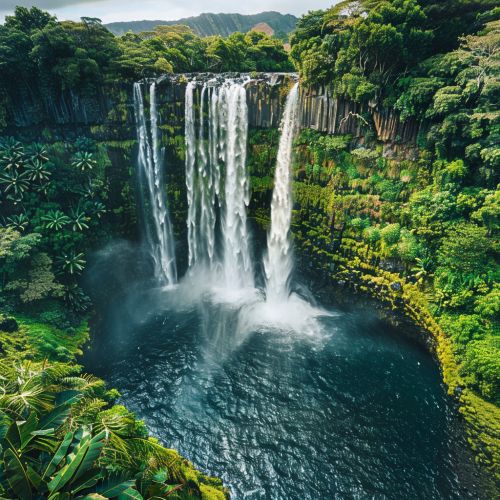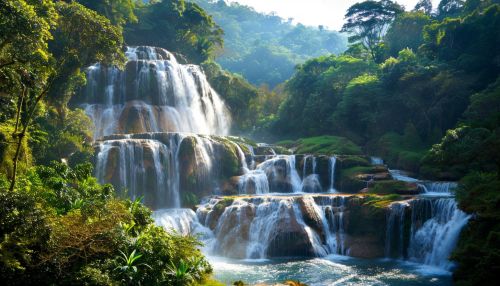Water Stewardship: Difference between revisions
(Created page with "== Introduction == Water stewardship refers to the responsible management and use of water resources in a way that is socially equitable, environmentally sustainable, and economically beneficial. It encompasses a broad range of activities, including water conservation, pollution prevention, watershed management, and the equitable distribution of water resources. Water stewardship is critical for ensuring the availability of clean water for future generations and maintai...") |
No edit summary |
||
| (One intermediate revision by the same user not shown) | |||
| Line 75: | Line 75: | ||
[[Category:Environmental Science]] | [[Category:Environmental Science]] | ||
[[Image:Detail-79163.jpg|thumb|center|A picturesque waterfall surrounded by lush greenery.|class=only_on_mobile]] | |||
[[Image:Detail-79164.jpg|thumb|center|A picturesque waterfall surrounded by lush greenery.|class=only_on_desktop]] | |||
Latest revision as of 10:46, 17 May 2024
Introduction
Water stewardship refers to the responsible management and use of water resources in a way that is socially equitable, environmentally sustainable, and economically beneficial. It encompasses a broad range of activities, including water conservation, pollution prevention, watershed management, and the equitable distribution of water resources. Water stewardship is critical for ensuring the availability of clean water for future generations and maintaining the health of ecosystems.
Historical Context
The concept of water stewardship has evolved over time. Early civilizations, such as those in Mesopotamia and the Indus Valley, developed sophisticated irrigation systems to manage water resources for agriculture. The Roman Empire built extensive aqueducts to supply cities with fresh water. In the modern era, the industrial revolution and rapid urbanization have increased the demand for water, leading to the development of large-scale water management projects, such as dams and reservoirs.
Principles of Water Stewardship
Water stewardship is guided by several key principles:
Sustainability
Sustainability involves managing water resources in a manner that meets current needs without compromising the ability of future generations to meet their own needs. This includes protecting water quality, maintaining ecosystem health, and ensuring the long-term availability of water resources.
Equity
Equity in water stewardship ensures that all individuals and communities have access to clean and safe water. This involves addressing disparities in water access and quality, particularly for marginalized and vulnerable populations.
Efficiency
Efficiency in water use involves optimizing the use of water resources to minimize waste and maximize benefits. This includes implementing water-saving technologies, reducing water loss in distribution systems, and promoting water-efficient practices in agriculture, industry, and households.
Collaboration
Effective water stewardship requires collaboration among various stakeholders, including governments, businesses, non-governmental organizations, and communities. Collaborative efforts can lead to more comprehensive and effective water management strategies.
Water Stewardship Strategies
Water Conservation
Water conservation involves reducing water use and waste through various methods, such as installing low-flow fixtures, repairing leaks, and using drought-resistant plants in landscaping. Public awareness campaigns and educational programs can also promote water-saving behaviors.
Pollution Prevention
Preventing water pollution is essential for maintaining water quality. This includes regulating industrial discharges, promoting the use of environmentally friendly products, and implementing best management practices in agriculture to reduce runoff of pesticides and fertilizers.
Watershed Management
Watershed management involves protecting and restoring the natural systems that collect, store, and filter water. This includes preserving wetlands, reforesting degraded areas, and managing land use to reduce erosion and sedimentation.
Equitable Water Distribution
Ensuring equitable access to water requires addressing disparities in water availability and quality. This can involve investing in infrastructure to provide clean water to underserved communities, implementing policies to protect water rights, and promoting community-based water management.
Challenges in Water Stewardship
Climate Change
Climate change poses significant challenges to water stewardship by altering precipitation patterns, increasing the frequency and severity of droughts and floods, and affecting water quality. Adaptation strategies, such as improving water storage and enhancing the resilience of water infrastructure, are essential for addressing these challenges.
Population Growth
Rapid population growth increases the demand for water and puts pressure on existing water resources. Sustainable urban planning, efficient water use, and investment in water infrastructure are critical for meeting the needs of growing populations.
Pollution
Water pollution from industrial, agricultural, and urban sources remains a major challenge. Strengthening regulations, improving waste management practices, and promoting the use of green technologies are necessary to reduce pollution and protect water quality.
Governance
Effective water stewardship requires strong governance frameworks that promote transparency, accountability, and stakeholder participation. This includes developing and enforcing water laws, establishing clear water rights, and promoting integrated water resources management.
Case Studies
The Murray-Darling Basin, Australia
The Murray-Darling Basin is one of Australia's most important agricultural regions, but it has faced significant water management challenges, including over-extraction, pollution, and climate variability. The Basin Plan, implemented in 2012, aims to balance water use with environmental sustainability by setting limits on water extraction, restoring wetlands, and improving water quality.
The Colorado River Basin, USA
The Colorado River Basin supplies water to over 40 million people and supports agriculture, industry, and ecosystems across seven U.S. states and Mexico. The basin faces challenges such as overallocation, drought, and climate change. Collaborative efforts, such as the Colorado River Water Users Association and the 2012 U.S.-Mexico agreement, have focused on improving water management, promoting conservation, and enhancing cross-border cooperation.
Future Directions
The future of water stewardship will require innovative approaches and continued collaboration among stakeholders. Emerging technologies, such as remote sensing, artificial intelligence, and desalination, offer new opportunities for improving water management. Additionally, integrating water stewardship into broader sustainability and development agendas can help address the interconnected challenges of water, food, and energy security.
See Also
References


